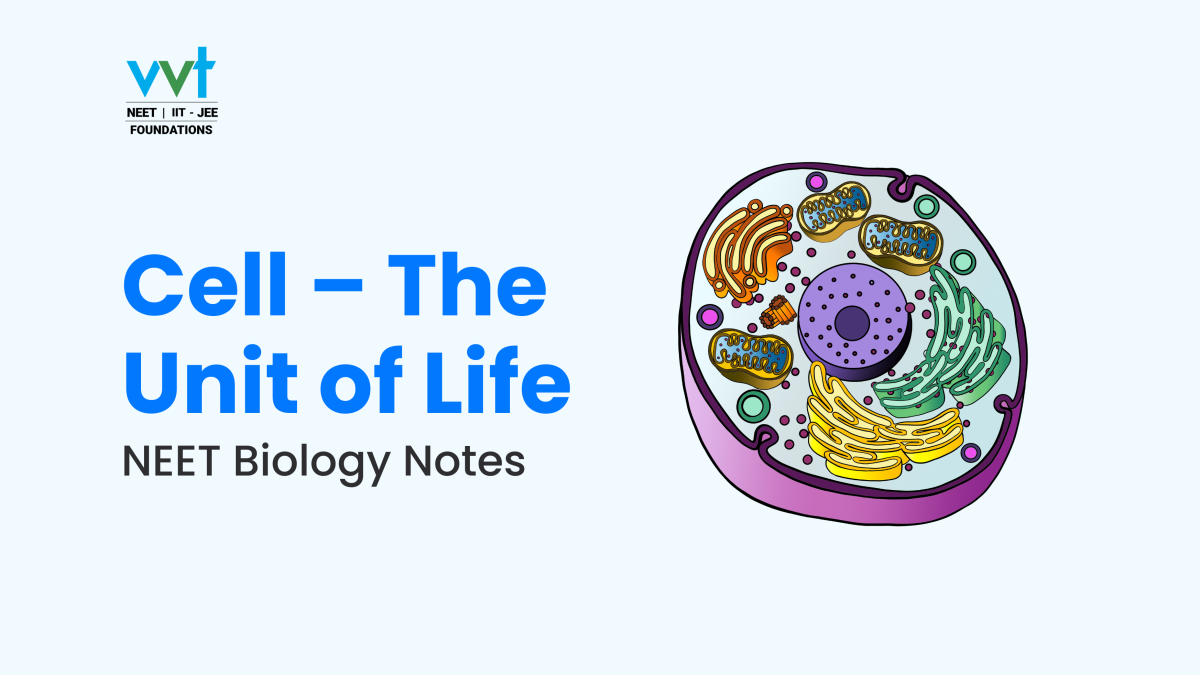
5 Critical Mistakes in NEET Chemistry MCQs and How to Avoid Them | VVT Coaching
April 18, 2025
Motion in a Plane: A Comprehensive Guide for NEET
April 22, 2025Cell – The Fundamental, Structural, and Functional Unit of Life | NEET Notes | VVT Coaching
In this article, we will delve into the intricate world of cells, understanding why they are considered the building blocks of all living organisms.
From their discovery to their complex structures and functions, we’ll cover it all in a way that’s easy to grasp and perfect for your exam preparation. Whether you’re revising for NEET or exploring biology for the first time, VVT Coaching is here to help you succeed.
Let’s embark on this journey to master cell biology!
What is a Cell?
A cell is the smallest unit of life that can replicate independently and perform all essential functions of life. It is often referred to as the “fundamental unit of life” because all living organisms are made up of cells. The term “cell” was coined by Robert Hooke in 1665 when he observed cork under a primitive microscope. Since then, our understanding of cells has grown significantly, leading to the formulation of the cell theory by Matthias Schleiden and Theodor Schwann in the 19th century.
Key Points of Cell Theory:
- All living organisms are composed of cells (or products of cells).
- The cell is the basic structural and functional unit of life.
- All cells arise from pre-existing cells (a contribution by Rudolf Virchow).
Cells vary greatly in size and shape. For example, Mycoplasma is the smallest known cell at 0.3–0.34 μm, while an ostrich egg is the largest single cell. In humans, erythrocytes (red blood cells) are about 7 μm in diameter, and nerve cells (neurons) are among the longest, extending across the body.
Types of Cells
Cells are broadly classified into two types based on their structure and complexity:
- Prokaryotic Cells:
- Found in organisms of the Kingdom Monera, such as bacteria, cyanobacteria (blue-green algae), Mycoplasma, and PPLO (Pleuro Pneumonia Like Organisms).
- These cells lack a true nucleus and membrane-bound organelles.
- They contain plasmid DNA, which can confer resistance to antibiotics and is used in bacterial transformation.
- Unique structures like pili (elongated tubular structures for conjugation) and fimbriae (bristle-like fibers for attachment) are often present.
- Example: Mycoplasma, which lacks a cell wall and is pleomorphic (variable in shape).
- Eukaryotic Cells:
- Found in plants, animals, fungi, and protists.
- These cells have a true nucleus enclosed by a nuclear membrane and contain membrane-bound organelles like mitochondria, endoplasmic reticulum, and Golgi apparatus.
- Eukaryotic cells are generally larger and more complex than prokaryotic cells.
Comparison of Prokaryotic and Eukaryotic Cells
| Feature | Prokaryotic Cells | Eukaryotic Cells |
| Nucleus | Absent (nucleoid region) | Present (enclosed by nuclear membrane) |
| Membrane-bound Organelles | Absent | Present (e.g., mitochondria, ER) |
| Size | Smaller (1–10 μm) | Larger (10–100 μm) |
| DNA | Circular, not associated with histones | Linear, associated with histones |
| Examples | Bacteria, Mycoplasma | Plants, Animals, Fungi |
Structure of a Cell
A typical eukaryotic cell is a complex system with various components that work together to sustain life. Below, we explore the key structures:
- Cell Membrane:
- The outermost layer of the cell, composed of a phospholipid bilayer.
- Regulates the movement of substances in and out of the cell.
- Contains proteins that act as receptors, channels, and enzymes.
- Cytoplasm:
- A gel-like substance that fills the cell and suspends organelles.
- Contains cytosol (the fluid part) and various biomolecules like proteins, carbohydrates, and lipids.
- Nucleus:
- The control center of the cell, containing genetic material (DNA) organized into chromosomes.
- Surrounded by a double-membrane nuclear envelope with pores for transport.
- Contains the nucleolus, where ribosomal RNA (rRNA) is synthesized.
- Organelles:
- Specialized structures with specific functions:
- Mitochondria: Known as the “powerhouse” of the cell, produces ATP (energy) through cellular respiration.
- Endoplasmic Reticulum (ER): Rough ER synthesizes proteins; smooth ER synthesizes lipids.
- Golgi Apparatus: Modifies, packages, and transports proteins and lipids.
- Lysosomes: Contain digestive enzymes to break down waste and cellular debris.
- Chloroplasts (in plant cells): Site of photosynthesis, converting light energy into chemical energy.
- Specialized structures with specific functions:
Major Cell Organelles and Their Functions
| Organelle | Function |
| Mitochondria | Energy production (ATP) via cellular respiration |
| Endoplasmic Reticulum | Protein (rough ER) and lipid (smooth ER) synthesis |
| Golgi Apparatus | Packaging and transport of proteins and lipids |
| Lysosomes | Digestion of waste and cellular debris |
| Chloroplasts | Photosynthesis (in plant cells) |
Functions of Cells
Cells are not just structural units; they are also functional units that perform all the essential processes of life. Here are some key functions:
- Metabolism:
- Cells carry out chemical reactions to produce energy (e.g., cellular respiration) and synthesize molecules (e.g., proteins, lipids).
- Growth and Development:
- Cells divide (through mitosis) to increase in number, leading to the growth of tissues and organs.
- Reproduction:
- Cells can divide to form new cells, either for growth or to repair damaged tissues.
- Response to Stimuli:
- Cells can detect changes in their environment (e.g., temperature, light) and respond accordingly (e.g., through movement or chemical signaling).
- Homeostasis:
- Cells maintain a stable internal environment by regulating processes like osmosis and ion balance.
Importance of Cells in Biology
Understanding cells is crucial for several reasons:
- Foundation of Life: Cells are the smallest units that can perform all life functions independently.
- Disease Understanding: Many diseases, such as cancer, are rooted in cellular malfunctions.
- Biomedical Research: Knowledge of cell structure and function is essential for developing treatments and therapies.
- NEET Preparation: Cell biology is a high-weightage topic in NEET, often contributing around 7% of the biology section. Mastering it can help you score well.
| NEET Chapter Wise Weightage 2025 for Biology | |
| Topics | Weightage (%) |
| Cell : The Unit of Life | 5% |
Conclusion
In conclusion, cells are indeed the fundamental, structural, and functional units of all living organisms. From the smallest Mycoplasma to the largest ostrich egg, cells exhibit remarkable diversity and complexity. Mastering this topic is essential for NEET 2025 success, as it forms the foundation for understanding more advanced biological concepts.
With VVT Coaching’s detailed notes, tables, and FAQs, you’re well-equipped to tackle any question on cell biology. Keep practicing, and remember, VVT Coaching is your partner in achieving your dreams!
Also read:
- NEET Chapter Wise Weightage 2025
- NEET Physics Chapter-Wise Weightage
- NEET Chemistry Chapter-wise and Concept-Wise Weightage
Frequently Asked Questions (FAQs)
- What is the smallest cell?
Mycoplasma, with a size of 0.3–0.34 μm, is the smallest known cell. - Who discovered the cell?
Robert Hooke discovered the cell in 1665 while observing cork under a microscope. - What is the difference between prokaryotic and eukaryotic cells?
Prokaryotic cells lack a true nucleus and membrane-bound organelles, while eukaryotic cells have both. - What is the function of the nucleus?
The nucleus contains DNA and controls cellular activities by regulating gene expression. - Why are cells important for NEET preparation?
Cells are a fundamental topic in biology, and questions on cell structure, function, and theory are frequently asked in NEET.











